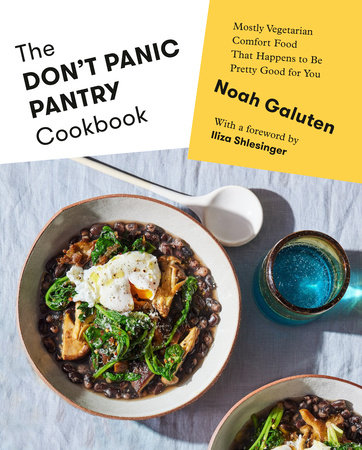Pantry prep
(Things to make and keep on hand)
A Pot of Beans
Make 5 to 6 cups
Beans are one of the great sustainable, nutritious foods on the planet, filled with protein, fiber, vitamins, and minerals. While I always keep canned beans at the ready, I greatly prefer to cook a pot of beans from scratch, which usually results in a better bean that costs less money (with the added benefit of flavoring them however you see fit).
Additionally, you will start to discover different types of beans, and higher quality beans. Some of my favorites come from Rancho Gordo, a company that focuses on growing heirloom varietals of exceptional quality and beauty, while also supporting growers across North America, as well as working with small farms in Mexico to produce rare crops.
There are many ways to cook beans, but over the years I have landed on this oven method as my absolute favorite for creating an even, gentle cook with perfect results (though I have included a stovetop method as well). I also think that soaking your beans in advance is a waste of time that does not produce a higher quality cook, nor does it “de-gas” the beans, an urban myth that has been debunked by people far smarter than me.
1 pound dried beans, rinsed and sorted for small rocks
About 7 cups water
Salt
Equipment Ovenproof pot with a heavy lid (I use a 41/2-quart Dutch oven)
Oven Method Preheat the oven to 325°F.
In an ovenproof pot with a lid (such as a Dutch oven), combine the beans, water, and a healthy pinch of salt (you are looking for about 2 inches of water above the beans). Bring the pot to a boil on the stove and taste the water for seasoning—it should be seasoned like a mellow broth. Cover the pot and transfer it to the oven.
Bake until fully tender all the way through, 11/2 to 21/2 hours. The cooking time can really vary, depending on the type of beans and how old they are. Also keep an eye on the water level, as if there is too little water, the beans will not fully cook. You always want to keep at least an inch of liquid above the beans.
If the beans seem very close to being done, you can turn off the oven and let them finish in the residual heat. Let them cool completely before storing them in the refrigerator. Store the beans completely submerged in their cooking liquid.
Stovetop Method In a Dutch oven, combine the beans, water, and a healthy pinch of salt (you are looking for about 2 inches of water above the beans). Bring the pot to a boil on the stove and taste the water for seasoning—it should be seasoned like a mellow broth. Cover the pot and keep it at a bare simmer on the stove, stirring occasionally, until the beans are fully tender all the way through, 11/2 to 21/2 hours. The cooking time can really vary, depending on the type of beans and how old they are. Keep an eye on the water level, as if there is too little water, the beans will seem to never fully cook. You always want to keep at least an inch of liquid above the beans.
Let them cool completely before storing them in the refrigerator. Store the beans completely submerged in their cooking liquid.
Bean Variations
While I often cook my beans with just water and salt so that they will hold up well to any number of applications, sometimes I add a few other ingredients, just to impart extra flavor.
Try adding ingredients like these, in any combination, right at the beginning with the cold water:
Leek tops (the tough, green tops, thoroughly washed)
An onion or a pair of shallots, peeled and halved
A head of garlic, halved horizontally
A few sprigs fresh herbs, like rosemary, thyme, or parsley, tied together with kitchen twine
A bay leaf
A fresh chile, halved lengthwise
A Parmesan rind
Olive oil or lard
If you want to add a piece of meat, I recommend a smoked ham hock (the greatest bean meat) or any end of flavorful meat that you have on hand, like a prosciutto heel. But I’ll add one caveat, via my friend and mentor Kevin Bludso: If you are adding meat, let it simmer for about an hour before adding the beans (though you can put the aromatic vegetables in there with the meat, too, if you like). The reason being that you want the water to take on the flavor of the meat, like a stock, before it begins absorbing into the beans. Stock takes longer to make than beans do, so let that flavor really develop.
Chicken Stock
A Philosophical Treatise That Also Includes a Recipe
An 8-quart stockpot will yield 3 to 4 quarts of stock
A 16-quart stockpot will yield 7 to 8 quarts of stock
Homemade chicken stock is one of the greatest things in the world—a golden nectar, extracting the truest essence from spare chicken parts and vegetable bits and transferring their properties into liquid form. Having it on hand means you can make a quick soup for yourself with deep, satisfying flavors, like Jewish Italian Chicken Noodle Soup (page 133), Ginger-Cilantro Chicken Noodle Soup (page 134), Shrimp Soupy Rice (page 128), or any number of recipes beyond the ones in this book.
Canned or boxed chicken broth is a woefully inadequate facsimile that has gradually and relentlessly made people forget what the real stuff is supposed to taste like. They often contain sodium, sugar, and “dehydrated chicken,” as well as vegetable juice concentrates and yeast extract. They also, in almost all instances, contain an ingredient simply listed as “chicken broth.” (What if you bought a bottle of ketchup and the first ingredients was “ketchup”?) I did a lot of research on this subject for an article that has grown ever more complex (and may never actually be completed). What I discovered, for the most part, is that boxed and canned broths start with a broth concentrate, made by a multinational corporation (they often describe their product as a “turnkey broth solution”) that then sells it to different consumer-facing companies (these are the “brands” you’ve heard of) that then add their own flavorings and water to it to make it their own special “recipe.” But basically, if you’re buying any stock or broth in a box or a can, there is a very high probability that it is made by one of three gigantic multinational corporations that you have never heard of before.
Now look—I totally get that making real chicken stock takes up time that many of us don’t have. But in truth, it’s very simple: You simmer bones and vegetables for a few hours in some water and then you strain it. Personally, I find it to be a calm and meditative experience that does not require your full attention—something you can do when you have a day off at home. It is a down payment on your future meals and makes your house smell like a home. I always make a big batch, then transfer it into 1-quart deli containers and freeze whatever I don’t plan on using within the next few days. Then whenever I want some, I can set it in the fridge the day before to thaw. Or I just run the container under cold water to loosen it up and then dump it into a pot, cover, and let it melt over medium heat. You can also pour your stock into ice cube trays and freeze it, then transfer the cubes to freezer bags.
Great chicken stock makes even the simplest dishes taste outstanding.
Some quick notes on making stock:
•Use the biggest pot you have on hand. I fill my largest pot up about 60 percent of the way with chicken bones and then I fill the rest of it up with water.
•You can use any chicken bones, like necks and backs, or even the carcass of a leftover roast chicken. You can also mix and match. I like to mix in some chicken feet if I can get my hands on them—they have extra collagen and bring a wonderful richness and body to the stock.
•I always keep a freezer bag going with various spare backbones or roast chicken carcasses that I will eventually use to make stock.
•You can also use whole chicken pieces, or even a whole chicken cut up into pieces. The meat will give more flavor to the broth; you can then pull the meat off the bones at the end for other uses.
•I tend to use a classic combination of celery, carrot, onion, peppercorns, and parsley stems, but you can modify to fit your taste. Garlic can be nice, or ginger. I often use the tough green tops of leeks, too. If you want your stock to be darker, you can leave the onion skins on the onions.
•Some people roast their raw bones to give color to the stock as well, but I prefer a lighter, clearer, more nuanced hay-colored stock.
Chicken bones, pieces, and carcasses: 4 pounds for an 8-quart stockpot; 8 to 9 pounds for a 16-quart stockpot
A few celery stalks with their leaves, washed and broken in half
A couple of carrots, washed and broken in half
An onion, halved and peeled, or the tough green top from a few leeks
A few peppercorns
A handful of parsley stems
Equipment Heavy-bottomed stockpot with a lid (the bigger the pot, the better), fine-mesh sieve, cheesecloth (optional), and 1-quart deli containers
Place the chicken bones and pieces in a large stockpot and fill the pot with water—leaving about 11/2 inches of space at the top for bubbling: 4 to 5 quarts for an 8-quart stockpot and 8 to 9 quarts for a 16-quart stockpot. Bring to a boil—this will agitate the chicken bones and start releasing some foamy scum. Let it boil for about 5 minutes, reducing the heat if it is boiling too aggressively. After 5 minutes, reduce the heat to a very gentle simmer, then take a ladle and gently lower it into the pot to scoop up all of the scummy foam and throw it away.
Keep the pot at a bare simmer for about 2 hours (boiling too much will evaporate most of the water out). After 2 hours, add the vegetables, peppercorns, and parsley stems. At this point you can cook the stock at a lower heat, uncovered, so that it is barely bubbling at all—but the pot should be so hot that you cannot hold your finger on the outside of it for longer than a second.
Continue cooking the stock for at least 2 more hours, or as long as you are interested in doing it. I have friends who cook chicken stock for 18 hours, but truthfully, I usually only leave mine on the stove for about 6 hours. The good thing, though, is that if you are busy, you can just check on it from time to time and leave it be for as long as you want.
Once you think the stock is where you want it, ladle a little of it into a mug and season it with salt. If you are happy with the taste and texture, it is ready.
I will often use tongs to lift out and discard as many bones and scraps as I can before straining. If you have cheesecloth, use it to line a sieve and set the sieve over another pot or bowl, and ladle the stock into the sieve. (Or simply pour the stock slowly into an unlined sieve.) The goal is to be somewhat gentle so that the weight of the liquid doesn’t push impurities through the sieve. Leave behind and discard any sediment at the bottom of the stockpot.
You can, if you are inclined, rinse the stockpot and then strain the stock one more time back into the pot.
To remove excess fat (especially from a stock that used a lot of chicken feet, or a roasted chicken carcass), allow the pot of stock to settle for a few minutes, then gently lower a ladle so that it just barely breaks through the surface of the liquid. The fat, having risen to the top, will fall into the ladle. Continue this until you’ve removed most of the fat from the stock. Alternatively, you can wait until the stock is refrigerated or frozen and then simply scoop it out (it will be opaque and look quite different from the rest of the stock).
Transfer the stock into containers and allow it to cool completely before storing it in the refrigerator or freezer.
Pastina with Chicken Broth
When I was little and got sick, my mom would sometimes make me a bowl of chicken broth with boiled pastina, orzo, or stars—though any tiny pasta shape will do. It is then finished with grated Parmesan cheese, salt, and black pepper. Simply boil the pasta separately from the stock, in salted water. Then heat the stock and season it to taste with salt. Drain the cooked pasta and add it to the bowl, adding the stock and topping it with cheese and black pepper.
It is, to this day, a deeply comforting thing to eat when I am sick, and also one of the purest ways to enjoy the virtues of excellent homemade chicken stock.
Escarole and White Bean Soup
Along those same lines, escarole and white bean soup is another classic use for good chicken stock. This is something I make in the morning on Thanksgiving, because it is nutritious and light to eat a bit of throughout the day, without ruining my appetite for the big dinner.
Just set a few cups of chicken stock in a pot on the stove and then ladle in some cooked white beans, a handful of chopped escarole, and a Parmesan rind. Then simmer it all together for about 10 minutes, season it to taste with salt, and pepper and keep it warm on the stove, eating it whenever you feel inclined.
Vegan Dashi
Makes about 4 cups
Dashi is a broth that is the base of a lot of Japanese cooking. While there are many kinds of dashi, the most popular by far uses kombu (dried kelp) and katsuobushi (smoked fish shavings, also known as bonito flakes). But I often find myself making this simple, vegan version that uses just water, kombu, and dried mushrooms. You can even leave the mushrooms out entirely, though I find that I like the extra bit of earthy, umami punch that it gets.
I present two methods of this recipe—one is an overnight “cold brew” recipe in which you just let it all sit at room temperature for 8 to 10 hours. The faster (and only slightly less good) version involves the stove and takes about 10 minutes, but requires you to wash a pot.
After you have made dashi, the strained out mushrooms and konbu can be used again (via the stovetop method) to make another batch of less nuanced dashi, called “secondary dashi.” Think of it like that second, weaker cup of tea you can make with the same leaves you used for the first one.
Copyright © 2023 by Noah Galuten. All rights reserved. No part of this excerpt may be reproduced or reprinted without permission in writing from the publisher.







